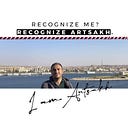Eliz Partamian The Impasto Artist
Eliz Partamian, an Egyptian-Armenian artist who born on December 10, 1930 and died on August 23, 2007, received her elementary education initially at Kalousdian Armenian School in Cairo, graduating in 1944, then from 1944–1947 at Immaculate Conception School (I.C.S.), a secondary school established at Cairene Sabteya quarter by Irish Catholic sisters.
Eliz enjoyed drawing ever since she was a young child, and in 1943, while a student at Kalousdian, she won the top prize in an annual exhibition that was held as one of the school's extracurricular activities under the guidance of her art teacher Ashod Zorian (1905–1975). She was greatly inspired by this, and eventually, like Hasmig Ballarian and Nora Ipekian-Azadian before her, she became one of Zorian's close students, spending the years 1943–1951 learning under the master.
After graduating from Paris' "Cours ABC" in 1966, Eliz attended the "Salon Du Caire" the following year. But her real beginning came in 1968, when she held her first solo exhibition from December 24 to 30, 1968, at Carzou Gallery, a gallery founded by the Armeno-Egyptian community inside the Kalousdian School building (it was opened on May 11, 1967, and was regularly used until 1979).
In this early exhibition, the majority of her pieces were portraits, scenes, and flower-filled vases, all of which were in the Ashod Zorian tradition. However, after that, she gradually added new themes to her artwork while maintaining these more conventional ones, particularly those that reflected feminine themes like "Mother and child" and "Maternity.".
Technically, her style was superior to the stylized realism of her master and came close to Fauvism and Expressionism. She boldly applied the Impasto technique to cover the surfaces of her works, which involves thickly applying paint to a surface so that brushstrokes or palette knife marks are visible. Her lines became stronger, her compositions more balanced, and she used it to cover the surfaces of her works. Because of this, a trained eye can recognize her works with ease today.
Solo Exhibitions
The artist held three additional solo exhibitions after this initial one, in addition to taking part in numerous group exhibitions. The Goethe Institute in Cairo, a West German cultural hub, hosted her second solo exhibition. The great cartoonist Alexander Saroukhan opened this exhibition, which ran from April 28 to May 12, 1975. A total of 40 pieces were displayed. These included "The Bloody Tower" (of London), "Cold Wind," "The Caravan," "The Doorkeeper's Daughter," "Arousat el-Mouled" (mouled refers to the birthday of the prophet Mohamed, while Arousa is a female figure made of sugar), "Fishermen," etc. Some of these reflected new and original subject matter, surpassing traditional ones, alongside figures, blooms, and scenes from nature (e.g. scenes of the Greek Aegean islands of Chios and Mikonos). Eliz Partam's full maturity was on display in this second exhibition.
From April 15 to April 18, 1979, a third solo exhibition took place at the "Atelier" of Alexandria in the large exhibition hall. Her most well-known painting, "Maternity" (created in 1978), was one of the 30 paintings she displayed this time. On this occasion, Mourad Keoshgerian published a significant article in Arev daily (the issue of May 9, 1979), in which he asserts that Maternity is a masterpiece.
Her fourth and final solo show took place at the AGBU Center in Los Angeles from June 20–29, 1980.
Group Exhibitions
Atelier of Alexandria (April 1980), Carzou Gallery (1969), AGBU Center in Beirut, Lebanon (1970), Armenian Artistic Club in Cairo (1979, 1980, 1989, and 1992), and four exhibitions in the Carzou Gallery (1979, 1980, 1989, and 1992) all hosted group exhibitions of works by Armeno-Egyptian artists. In honor of International Women's Day (also known as Mother's Day in Egypt), she also took part in a notorious group exhibition of 91 Egyptian female artists' works that was held in Cairo by the ministry of culture. The Fine Arts Hall in Bab el-Luq, Cairo, hosted it in March 1975.
